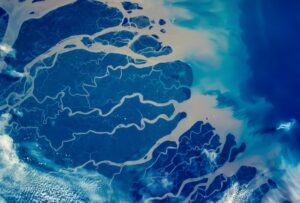In January, Masatatsu Abe finally reached the South Pole, after 55 days and 918km from the Messner Start. He was the last South Pole sledder of the year to finish. Recently, just after running the Tokyo Marathon, he took some time out to chat with ExWeb about his experience in Antarctica.
“I got absolutely smashed by the snow,” he said. “In particular, the first part was really difficult. [For the first 350km] it snowed continuously.”

Abe and this season’s other South Pole trekkers weren’t expecting to flounder in powder for 350km. With a heavy sled, it’s hard, slow aerobic work. Photo: Masatatsu Abe
Such soft snow is rare in dry and wind-raked Antarctica, and Abe found himself slipping further and further behind schedule. He found it hard to keep up morale. “I just focused on myself and doing my best each day,” said Abe. “Other people out there exchanged texts with each other about their progress and the conditions. I just shut all that out. It’s a bit strange to go all the way to Antarctica, then worry about what other people are doing.”


Who says the scenery in Antarctica is boring? Well, when it snows every day, pretty well everyone. Both: Masatatsu Abe
Abe’s goal was to complete the expedition solo and unsupported. But as he ate through his supplies, he had to make a tough decision: to resupply and lose his unsupported status or to try and make it to the end at the risk of running out of food.
“I didn’t make a firm decision until the final day. If it had not snowed any more, I could have made it to the Pole with the food I had left. But if it snowed just one more time, I would not have had enough.”
ALE could resupply almost anywhere along Abe’s route, except possibly between 88 and 89 degrees, where there many crevasses, and the pilots are reluctant to land. But the problem is the money: In Antarctica, a resupply by plane normally costs hundreds of thousands of dollars. Abe was on a tight budget and did not want to spend the rest of his life in debt.

Butter, the go-to food for Abe and most polar travelers. Despite the reassuring pile, it was not quite enough to take him to the South Pole without a resupply. Photo: Masatatsu Abe
However, there is a mandatory checkpoint (stipulated by ALE) that anyone doing the Messner or Hercules Inlet routes must visit. There, sledders can take extra supplies from a depot or even order a pickup for free, if they need to retire.There is a great deal of financial pressure to make a decision by that checkpoint.
“I wanted to go to the South Pole unsupported, but it was far more important to me that I made it to the South Pole, supported or not,” said Abe. “My main goal is the Shirase Route next year, so it’s important to demonstrate to ALE that I can complete an expedition in Antarctica. Nothing happens in Antarctica without their clearance.”

The last two-thirds of the trip featured better weather, although the sundog and wispy clouds behind Abe often presage a coming wind. Photo: Masatatsu Abe
In the end, Abe decided to take on enough supplies to guarantee this year’s success.
Before he left for Antarctica, he gave his social media followers an insight into his preparations. His weight-reduction measures included drilling holes in his toothbrush and even shaving off his body hair — dubious ways to save a gram or two.
One of his equipment choices, in particular, raised eyebrows: a three-kilo AIBO robot. “Before the ExWeb audience judges me too harshly, let me say it was really fun to have along. You can “play” and “communicate” with it, and it can sing songs to you. It’s also perhaps the first time a robot has traveled to the South Pole.” In terms of mitigating loneliness, shades of Tom Hanks and Wilson the vollyball.

Photo: Masatatsu Abe
Abe plans to make more important adjustments to his kit next time. “My repair kit was too large,” he admitted. “I was equipped for every eventuality, but I didn’t need so much. In retrospect, I would also have taken longer skis.” He was using 180cm skis for lightness, but 200cm would have floated better on the soft snow and breakable crust that characterized this difficult year.

Homemade windshield sewn onto goggles. Photo: Masatatsu Abe
While the snow hampered everyone, leading to some aborted treks, Abe says that it did not cause any danger, mainly thanks to ALE. “They run an incredibly tight operation and give comprehensive backup for everyone they drop off, including daily check-ins and rescue if something goes wrong,” Abe explained.

Polar travel would be a lot easier if you didn’t have to breathe and frost up all the clothing near your face. Photo: Masatatsu Abe
From the Messner Start to the checkpoint, he saw no ski tracks or points of reference. “It was tough but enjoyable –- a real expedition,” said Abe. “But from the checkpoint onward, there were tracks left by 4WD vehicles and other skiers, which made it much easier.”
Abe’s next target is that uncompleted Shirase Route, scheduled for this coming Antarctic season. Partly as training, he will pull his rickshaw around the Tohoku area of North Japan for two months. For the rest of the year, he will continue his work as a rickshaw driver in Asakusa, Tokyo. Visitors to Japan can ride on Abe’s rickshaw by booking here (in Japanese).

At long last, Abe reaches the South Pole. Photo: Masatatsu Abe






